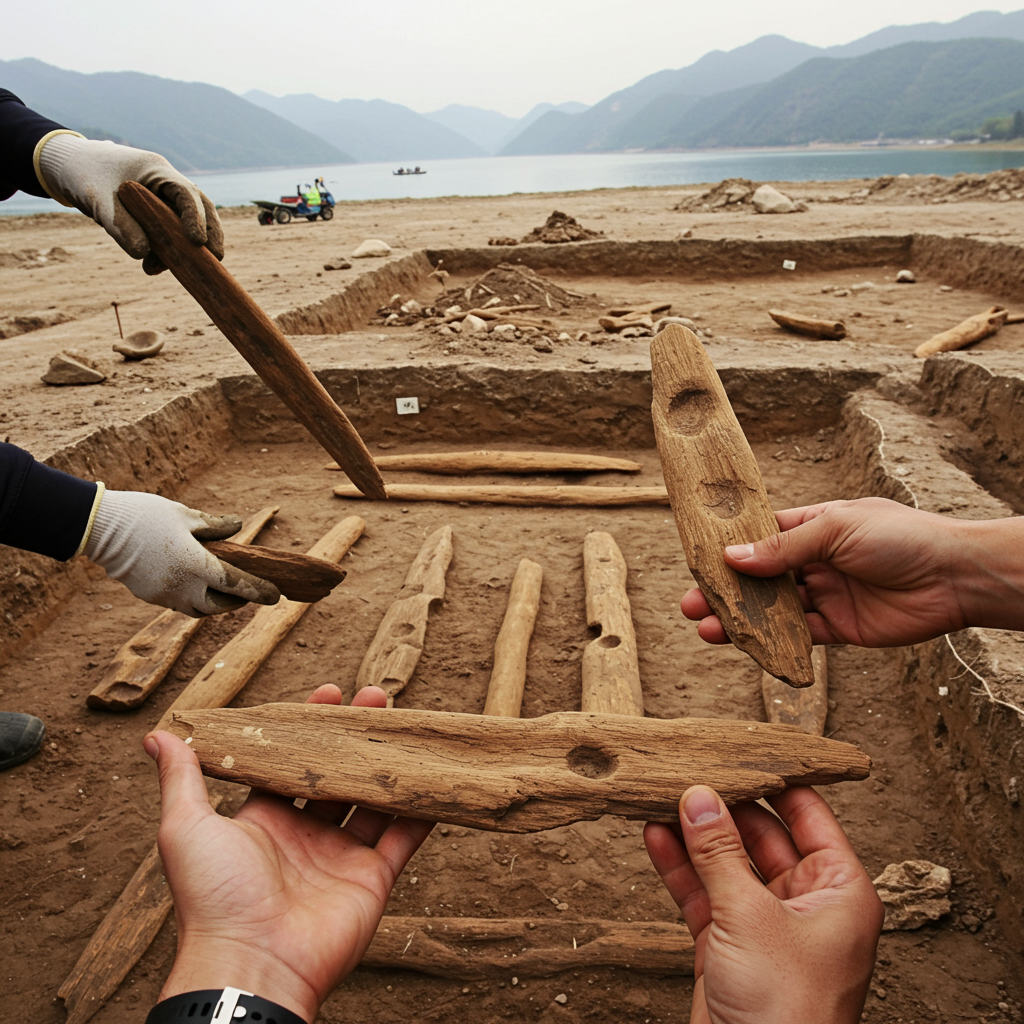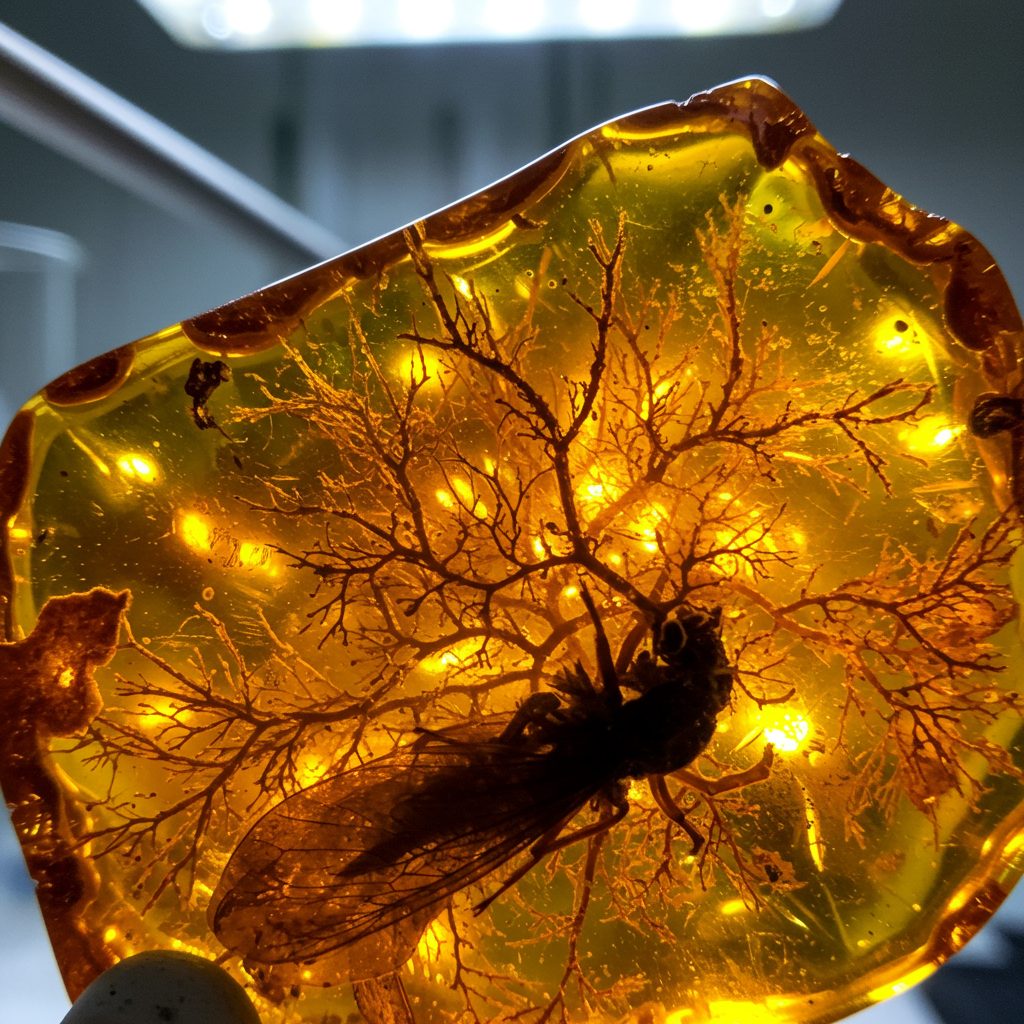Imagine peering back 300,000 years. What tools did early humans use? While stone artifacts dominate the archaeological record, a remarkable discovery in southwestern China is rewriting our understanding. Excavations at the <a href="https://news.quantosei.com/2025/07/05/tools-unearthed-in-china-are-first-evidence-of-east-asias-wood-age/" title="Ancient wooden Tools in China Reveal East Asia's 'Wood Age'”>gantangqing site on the ancient shores of Fuxian Lake have unearthed incredibly rare, well-preserved wooden tools. These findings offer unprecedented insights into the surprising sophistication and plant-focused lifestyle of early humans in this subtropical region during the Stone Age.
For decades, our view of Palaeolithic technology has been skewed. Stone tools survive weathering and time, preserving a record of ancient craftsmanship. Organic materials like wood, however, typically vanish. This makes discoveries of ancient wooden implements exceptionally significant.
Why Finding Ancient Wood Tools is Revolutionary
Wood decays quickly. Microbial activity, oxidation, and environmental breakdown rapidly destroy organic matter. Unlike resilient stone or bone, wood rarely lasts for more than a few centuries under normal conditions. Its survival over thousands or even hundreds of thousands of years is extraordinary.
Exceptional circumstances are required for wood to endure deep time. Oxygen-free environments or extremely arid conditions can halt decomposition. Charred or fire-hardened wood also gains remarkable durability. At Gantangqing, the wooden artifacts were buried. They were found in layers of clay-heavy sediment near the ancient lakeside. These sediments created low-oxygen conditions ideal for preservation.
Such ancient wooden implements are virtually absent from the Early Palaeolithic record outside of Africa and western Eurasia. This scarcity has perhaps led archaeologists to overemphasize the role of stone tools. The Gantangqing find reminds us that organic technologies were likely central to ancient human life. We just haven’t found much evidence until now.
The Unique Gantangqing Discovery
The recent excavations at Gantangqing (conducted in 2014-15 and 2018-19) yielded a stunning collection. Researchers identified 35 wooden specimens as intentionally modified tools. The majority were crafted from pine wood. A smaller number were made from harder woods.
These tools show diverse forms and modifications. Some feature rounded ends. Others have thin, chisel-like blades or ridged blades. A significant 32 out of the 35 tools bear clear marks of deliberate shaping. These modifications appear at tips, working edges, or bases.
Notable findings include two large implements. These were identified as heavy-duty digging sticks. They appear designed for two-handed use. These specific digging implement forms have not been documented elsewhere. This suggests functional adaptations specific to the Gantangqing inhabitants. Four distinct hook-shaped tools were also recovered. These were likely used for cutting roots. A series of smaller tools suitable for one-handed use were also present.
Microscopic analysis revealed further details. Nineteen tools showed traces of scraping. This indicates either shaping during manufacture or wear from use. Seventeen specimens exhibited deliberately polished surfaces. Evidence of intensive use was also found. This included soil residues stuck to tool tips. Parallel grooves or streaks appeared along working edges. Characteristic fracture wear patterns were also observed. Compared to contemporary sites like Clacton in the UK or Florisbad in South Africa, the Gantangqing tools are more complete. They also demonstrate a wider range of functions.
Unearthing the Timeline
Determining the exact age of these wooden tools required sophisticated techniques. Direct dating of the wood wasn’t possible. Instead, scientists focused on dating the surrounding sediment layers.
The team used infrared stimulated luminescence dating. They analyzed over 10,000 individual mineral grains from different layers. This technique measures when the grains were last exposed to sunlight. The analysis showed the sediment was deposited between approximately 350,000 and 200,000 years ago.
Further corroboration came from a mammal tooth. A tooth found in one of the layers was dated using a different technique. Its age was determined to be around 288,000 years old. This result was consistent with the sediment dating. By applying mathematical modeling, the team synthesized all the dating results. The model pinpointed the layers containing both stone and wooden tools. These artifacts date from 360,000–300,000 years ago to 290,000–250,000 years ago. This places these tools firmly within the Early Palaeolithic period.
A Lush Environment and Plant-Rich Diet
The archaeological findings are complemented by environmental evidence. Research indicates the ancient humans at Gantangqing lived in a warm, humid environment. It was likely tropical or subtropical. Pollen extracted from the sediments supports this. It revealed 40 different plant families, confirming a warm climate.
Plant fossils provided further confirmation. Subtropical-to-tropical flora dominated the landscape. Trees, lianas, shrubs, and herbs were common. Wet-environment plants also indicated the local surroundings. These confirmed the area was a lakeside or wetlands.
Animal fossils found at the site align with this picture. Remains included rhinoceros, other mammals, turtles, and various birds. The ecosystem was likely a diverse mosaic. It included grassland, thickets, and forests. Evidence of diving ducks suggests the lake was substantial. It must have been at least 2–3 meters deep during the period of human occupation.
The abundance of plant remains suggests a critical food source. The site contained evidence of edible plants. These included storable pine nuts and hazelnuts. Fruit trees like kiwi were present. Raspberry-like berries and grapes grew nearby. Edible herbs and fern fronds were also available. Crucially, aquatic plants were abundant. These would have offered edible leaves, seeds, tubers, and rhizomes.
What These Tools Tell Us About Daily Life
The link between the tools and the plant evidence is compelling. Researchers propose the Gantangqing hominins relied heavily on these plant resources. Specifically, the wooden digging sticks appear designed for harvesting underground storage organs. Tubers and rhizomes could be dug from the shallow mud near the lake shore.
This activity implies a surprisingly sophisticated level of knowledge and planning. To effectively harvest these resources, early humans would have needed to anticipate seasonal plant availability. They needed to know exactly which parts of different plants were edible and nutritious. Furthermore, manufacturing specialized tools like digging sticks for this purpose indicates foresight and technological skill. These findings suggest planned foraging trips to the lake shore using purpose-built equipment.
The Global Significance of Gantangqing
The Gantangqing discovery holds immense significance for palaeoanthropology. These wooden implements represent the earliest known evidence globally for several key behaviors. They show the use of digging sticks for harvesting. They also demonstrate the exploitation of underground plant storage organs. This is particularly noteworthy within the Oriental biogeographic realm.
The find significantly expands our understanding of early hominin woodworking capabilities. It showcases sophisticated wood technology. This technology developed in a distinct environmental context compared to sites of similar age in Europe and Africa.
The hominins living at Gantangqing appear to have pursued a heavily plant-based subsistence strategy. This contrasts sharply with contemporary northern sites, such as Schöningen in Germany. At Schöningen, hunting large mammals was a primary survival strategy. The Gantangqing site underscores the importance of wood. It suggests that organic materials, not just stone, were crucial to “stone age” hominins worldwide. These wooden artifacts reveal manufacturing skills. In fact, they seem more sophisticated than the relatively rudimentary stone tools found at comparable sites across East and Southeast Asia.
Frequently Asked Questions
How were these ancient wooden tools preserved for so long?
Wood typically decomposes rapidly due to natural processes. The remarkable preservation at Gantangqing was due to unique environmental conditions. The tools were found buried in clay-heavy sediment layers near the ancient Fuxian Lake shoreline. These sediments created a low-oxygen environment. This lack of oxygen prevented the microbial activity and oxidation that normally break down organic materials like wood over time.
What types of specific wooden tools were found at the Gantangqing site?
The Gantangqing excavation uncovered 35 wooden specimens identified as modified tools. These include diverse forms crafted primarily from pine, with some hardwoods. Specific types identified are large, heavy-duty digging implements likely used with two hands, four distinct hook-shaped tools possibly for cutting roots, and various smaller tools designed for one-handed use. Many show deliberate shaping, polishing, and evidence of intensive use.
Why is the discovery at Gantangqing important for understanding early human life?
The Gantangqing site is crucial because its rare wooden tools provide direct evidence of behaviors previously inferred or undocumented in the region. It represents the earliest known use of digging sticks and exploitation of underground plant foods (like tubers and rhizomes) in the Oriental realm. The find demonstrates sophisticated woodworking skills among early hominins 300,000 years ago, highlighting the importance of organic technology. It also suggests a plant-based diet was central to their survival in this subtropical environment, offering a different picture of Stone Age life compared to sites where hunting dominated.
The Gantangqing discovery is a powerful reminder. The archaeological record is often incomplete. Surviving materials can give us a skewed picture of the past. Finding rare, well-preserved wooden tools opens a vital window. It reveals the ingenuity and diverse survival strategies of our ancient ancestors. These findings challenge previous assumptions about early human capabilities. They highlight the critical role organic materials played in shaping the lives of Stone Age people in East Asia.




